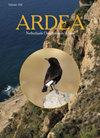气候对地中海游隼和兰纳隼繁殖物候的影响
IF 1.3
4区 生物学
Q3 ORNITHOLOGY
引用次数: 0
摘要
我们探讨了天气对生活在地中海西西里岛的地中海游隼Falco peregrinus brookei和Lanner Falcon F.biarmicus feldegii的时间和繁殖的影响。我们发现,在1979年至2019年期间,孵化的开始日期发生了变化,并分析了孵化时间是否影响两个种群的生产力,以及孵化日期和繁殖地质量的变化是否取决于气候条件。西西里岛春季气温和降雨量总体上升,游隼和兰纳猎鹰的孵化日期在1979年至2019年期间推迟了约一周。线性混合模型显示了冬季条件和随机效应(岛屿的气候部门,研究年份)对两个物种孵化日期的影响。二月降雨量的增加推迟了游隼的孵化,而我们无法确定兰纳猎鹰孵化延迟的具体月度影响。在这两个物种中,孵化日期的变化导致生产力(雏鸟数量)下降。春末的天气状况预测了兰纳猎鹰繁殖地的质量,但没有预测游隼的质量。两种猎鹰的繁殖表型都显示出对西西里岛天气状况的共同反应,然而兰纳猎鹰似乎比游隼对气候变化更敏感。气候影响加上其他人为影响,对欧洲最大的岛屿人口的未来生存产生了负面影响。本文章由计算机程序翻译,如有差异,请以英文原文为准。
Climate Effects on Breeding Phenology of Peregrine and Lanner Falcons in the Mediterranean
We explored the effects of weather on the timing and reproduction of the Mediterranean Peregrine Falcon Falco peregrinus brookei and the Lanner Falcon F. biarmicus feldeggii living on the Mediterranean island of Sicily. We found that the start date of incubation has changed during 1979–2019 and analysed whether incubation timing affected the productivity of both populations and whether the change of incubation date and the quality of breeding sites depended on climatic conditions. Overall spring temperature and rainfall increased on Sicily and the incubation date of the Peregrine and the Lanner Falcon has shifted to be about one week later over the time period 1979 to 2019. Linear mixed modelling showed the influence of winter conditions and random effects (climate sector of island, year of study) on incubation date in both species. The increase in February rainfall has delayed incubation in the Peregrine Falcon, while we could not identify a specific monthly effect delaying incubation in the Lanner Falcon. In both species, the shift in incubation date has resulted in a decrease in productivity (number of fledglings). Weather conditions in late spring predicted the quality of the breeding site of Lanner Falcons but not of Peregrines. The breeding phenology of both falcons shows a common response to weather conditions on Sicily, however the Lanner Falcon seems more sensitive than the Peregrine to the changing climate. Climate effects add to other anthropogenic impacts negatively affecting the future survival of this insular population, which is the largest in Europe.
求助全文
通过发布文献求助,成功后即可免费获取论文全文。
去求助
来源期刊

Ardea
生物-鸟类学
CiteScore
2.10
自引率
0.00%
发文量
49
审稿时长
>12 weeks
期刊介绍:
Ardea is the scientific journal of the Netherlands Ornithologists'' Union, and is published since 1912. The journal welcomes manuscripts reporting significant new findings in ornithology, in particular those covering the ecology, life history, and evolution of birds, and including sound descriptive work. Ardea publishes Original research papers, Short notes and Book reviews. In addition to the regular three issues per year, Ardea publishes specials that contain conference or workshop proceedings (produced on request).
 求助内容:
求助内容: 应助结果提醒方式:
应助结果提醒方式:


